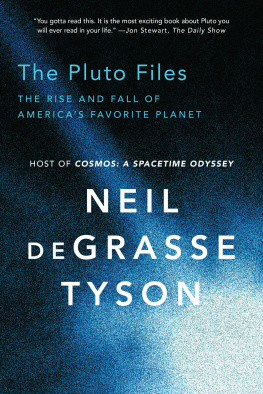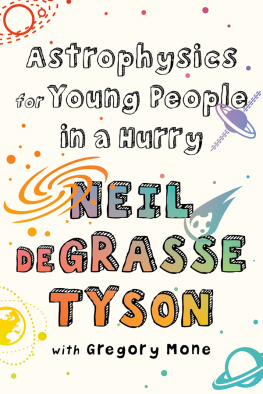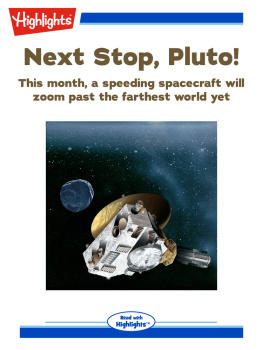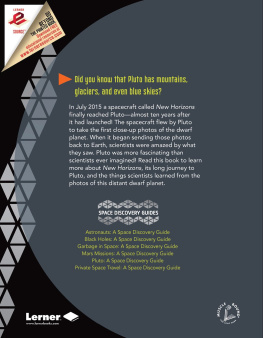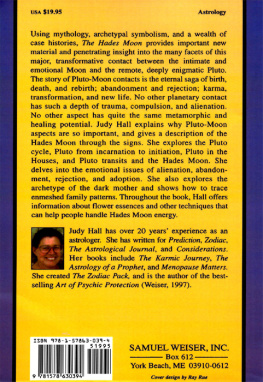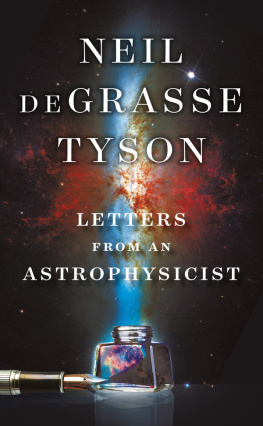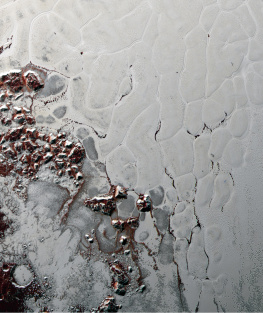A LSO BY N EIL DE G RASSE T YSON
S PACE C HRONICLES : F ACING THE U LTIMATE F RONTIER
D EATH BY B LACK H OLE AND O THER C OSMIC Q UANDARIES
O RIGINS : F OURTEEN B ILLION Y EARS OF C OSMIC E VOLUTION
( WITH D ONALD G OLDSMITH )
Neil deGrasse Tyson
THE PLUTO FILES
T HE R ISE AND F ALL OF A MERICAS F AVORITE P LANET
W. W. NORTON & COMPANY
NEW YORK LONDON
Copyright 2009 by Neil deGrasse Tyson
All rights reserved
First published as a Norton paperback 2009, reissued 2014
For information about permission to reproduce selections from this book, write to Permissions, W. W. Norton & Company, Inc., 500 Fifth Avenue, New York, NY 10110
For information about special discounts for bulk purchases, please contact W. W. Norton Special Sales at specialsales@wwnorton.com or 800-233-4380
Book design by Lovedog Studio
Production manager: Julia Druskin
The Library of Congress has cataloged the hardcover edition as follows:
Tyson, Neil deGrasse.
The Pluto files: the rise and fall of Americas favorite planet / Neil deGrasse Tyson.
p. cm.
Includes bibliographical references.
ISBN 978-0-393-06520-6 (hardcover)
1. Pluto (Dwarf planet) I. Title.
QB701.T97 2009
523.49'22dc22
2008040436
ISBN 978-0-393-07334-8 (e-book)
ISBN 978-0-393-35036-4 pbk.
W. W. Norton & Company, Inc.
500 Fifth Avenue, New York, N.Y. 10110
www.wwnorton.com
W. W. Norton & Company Ltd.
Castle House, 75/76 Wells Street, London W1T 3QT
To Plutophiles young and old

Letter from Taylor Williams, Mrs. Kochs second-grade class, Roland Lewis Elementary School, Tampa, Florida (spring 2008).
Contents
A Personal Recommendation for Educators

Preface
G ATHERED HERE IN ONE PLACE IS A RECORD OF P LUTOS RISE AND fall from planethood, given by way of media accounts, public forums, cartoons, and letters I received from disgruntled schoolchildren, their teachers, strongly opinionated adults, and colleagues.
In February 2000, the American Museum of Natural History opened its $230 million Frederick Phineas and Sandra Priest Rose Center for Earth and Space, containing the rebuilt Hayden Planetarium, on the corner of 81st Street and Central Park West in New York City. The newly conceived exhibits treated the solar system in a way that was without precedent for public institutions, even though murmurs had already begun in the planetary science community that something needed to be done about Plutos classification in the solar system.
The exhibit models, their accompanying text, and the overall layout of the Rose Center organized the principal contents of the solar system by objects of like properties, rather than as enumerations of planets and their moons. This decision landed Pluto among the growing number of icy objects found beyond Neptune and left it unmentioned and out of view among our models for the rocky, terrestrial objects (Mercury, Venus, Earth, and Mars) and the gas giants (Jupiter, Saturn, Uranus, and Neptune). By this organization, we practically abandoned the concept of planet altogether.
This decision represented the consensus of the science committee for the Rose Centers design and construction, of which I served as head. While the accountability and originality of our pedagogical approach to the subject lies equally among us on the committee, as director of the Hayden Planetarium I became the most visible exponent of this decision when, a full year after the Rose Center opened to the public, the New York Times broke a page 1 news story that we had demoted Pluto from its ranks of planethood. I was thenceforth branded a public enemy of Pluto lovers the world over.
This distinction prevailed until August 2006, when the International Astronomical Union (IAU), prompted by pressure from the professional community of planetary scientists as well as from the general public, brought Plutos planethood to a vote at a triennial general assembly in Prague, Czech Republic. The result? Pluto was formally downgraded from planet to dwarf planet, thereby helping to diffuse the negative attention that we had been receiving for six years running.
Its one thing for a single institution to reexamine Plutos standing in the solar system, but its quite another for an international organization of astronomers to do so. When the IAU voting results were released, a media frenzy followed, temporarily displacing news stories on terrorism, the Iraq War, genocide in Darfur, and global warming.
The Pluto Files chronicles and documents Plutos remarkable grip on the hearts and minds of the American public, the professionals, and the press.
Neil deGrasse Tyson
New York City
October 2008
The Pluto Files

Pluto in Culture
A T ABOUT FOUR IN THE AFTERNOON ON F EBRUARY 18 , 1930, 24-year-old Clyde W. Tombaugh, a farm boy and amateur astronomer from Illinois, discovered on the sky what would shortly be named for the Roman god of the underworld. Tombaugh had been hired by Arizonas Lowell Observatory to search for the mysterious and distant Planet X. The observatory was named and founded in 1894 by Percival Lowell, an independently wealthy American astronomer, who died in 1916, but not before launching the search that Tombaugh would complete. On March 13, 1930, Lowell Observatory went public with the news.
Shortly thereafter, two well-known architectural icons were out-of-date the day they were dedicated. On May 12, 1930, a mere two months after Plutos discovery, the Adler Planetarium, on Chicagos South Lake Shore Drive, opened for businessthe first of its kind in the Western Hemisphere and today the oldest surviving planetarium in the world. Adlers ornate entrance lobby had been designed well before Plutos discovery and displays a circle of plaques affixed to the wall that duly identifies a Plutoless family of eight planets in the solar system.
And in New York City, between Fiftieth and Fifty-first streets along Fifth Avenue, you will find, across the avenue from the main entrance to Saint Patricks Cathedral, a large and mighty brass statue of Atlas, designed by the sculptor Lee Lawrie in the 1920s and erected in the 1930s as part of the extensive art deco Rockefeller Center complex. You may remember from mythology class that for his misdeeds, Atlas was condemned by Zeus to stand on Earths western edge and hold the entire sky on his shoulders, preventing Earth and sky from resuming their primordial embrace. To represent the sky, Lawrie molded a spherical celestial grid, as is common for such artistic needs. But across Atlass yoke, Lawrie identified the symbol for each of the planets, Earths Moon included, lest you were not yet convinced that the known universe is what Atlas carried. Of course, in the 1920s Pluto had not yet been discovered, so once again Pluto was too late for the party. Atlass yoke identifies Mercury through Neptune, with no room for a ninth planet. No room for Pluto.
The world of music would be similarly afflicted.
In search of cosmic themes for his next orchestral work, the English composer Gustav Holst (18741934) wrote his seven-movement master-piece The Planets in 1916. Holst drew his musical themes from the lives and times of the Roman mythological characters after whom the planets were named. Of course, the music is absent a movement dedicated to Pluto, which had not yet been discovered, and its missing Earth, which was not a classical planet, leaving a count of only seven.

